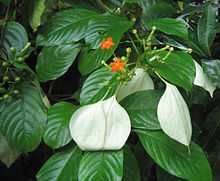Mussaenda frondosa
| Mussaenda | |
|---|---|
 | |
| Mussaenda frondosa | |
| Scientific classification | |
| Kingdom: | Plantae |
| Division: | Angiosperms |
| Order: | Gentianales |
| Family: | Rubiaceae |
| Genus: | Mussaenda |
| Species: | M. frondosa |
| Binomial name | |
| Mussaenda frondosa Linnaeus | |
| Synonyms[1] | |
| |
Also known as Wild mussaenda, or dhobi tree, is a plant of Rubiaceae family. It is a smaller shrub 1.5 to 2 metres (5 to 6 feet) tall by 1.5 to 2 metres (5 to 6 feet) wide. Like all other mussaenda species, petals are visible as pale white colored leaves just below the flower. Usually they arose with fruits. Known as "Wal buthsarana (වල් බුත්සරන)" in Sinhala language.
- Flowers - Clusters of orange-yellow tubular flowers beside large, white bracts, set among pale green, oval leaves; berries follow the bloom.
- Stem - The erect, branching stem has a shrubby crown.
- Medicinal value - The whole plant of Wild mussenda is used cough, bronchitis, fever, wounds, ulcers, leucoderma, pruritus, jaundice and Leaves make excellent herbal shampoo.
- Range - Native to India, Nepal, Sri Lanka, Cambodia, Vietnam, Malaysia and, Indonesia.
-

fruit
References
- ↑ "The Plant List: A Working List of All Plant Species". Retrieved 23 January 2015.